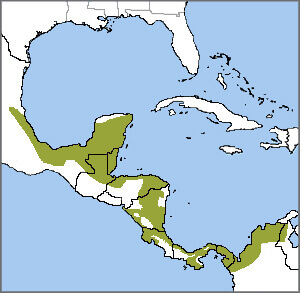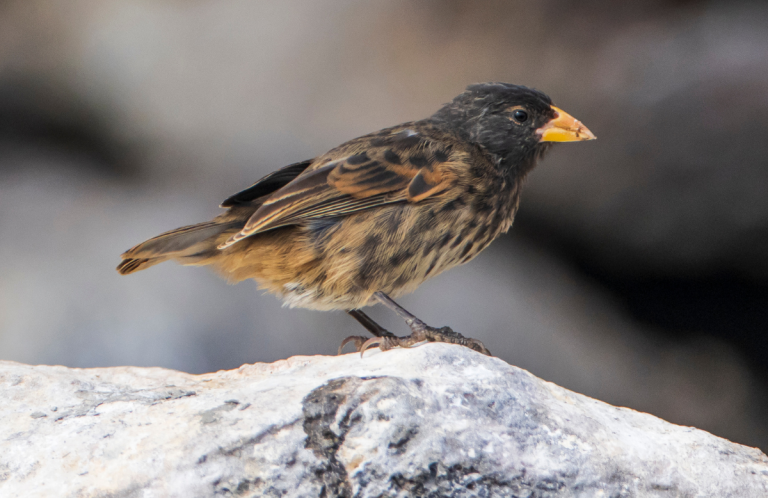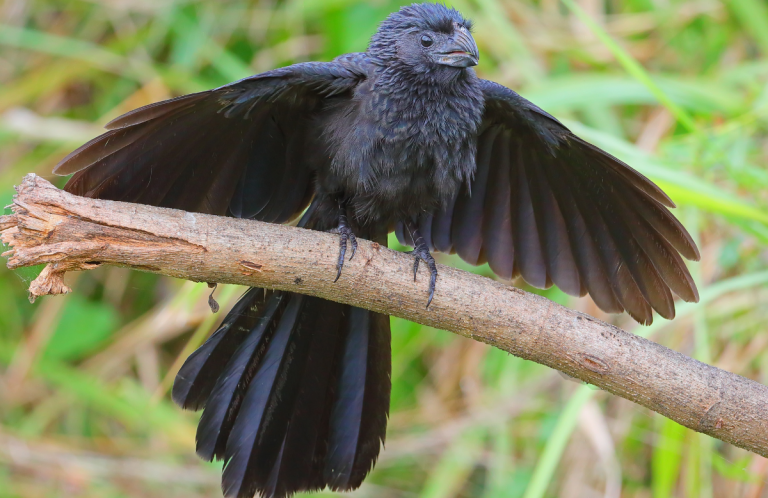
The Keel-billed Toucan's range extends from southern Mexico to northern Colombia and northwestern Venezuela. Map courtesy of NatureServe
The Keel-billed Toucan, also known as the Rainbow-billed Toucan, is notable for its colorful green, orange, red, and blue bill, which makes up about one-third of this bird's 20-inch length. While a bill this big may seem cumbersome, it's actually quite light, made of hollow, reinforced bone sheathed in keratin, the same protein found in human hair and nails.
This remarkable bill, a family feature shared by the Channel-billed Toucan and Saffron Toucanet, serves as a food-gathering tong, mate magnet, and fencing foil. These multipurpose mandibles also play another role that you might not expect.
Toucan Thermoregulation
A study in the journal Science found that a toucan's huge bill also functions as an efficient temperature regulation system. Researchers showed that the bill is laced with a fine network of blood vessels; by altering the blood flow to its bill in response to weather conditions, a toucan can adjust its internal body temperature.
(Audio by Peter Boesman, XC274645. Accessible at www.xeno-canto.org/274645)
Acrobatic Eater and Forest Gardener
The Keel-billed Toucan's diet, like that of many tropical birds, including the Oilbird and Golden-headed Quetzal, consists mostly of fruit. This toucan supplements its diet with insects and sometimes lizards; bird eggs and nestlings are also occasional food items. The surprisingly dexterous bill enables the bird to reach high-hanging fruit and probe deep into nests or tree crevices.
Upon finding a ripe fruit, the toucan snips it free with the tips of its mandibles, tosses it into the air, then tilts back its head and catches and swallows its prize whole. Toucans regurgitate larger seeds, sometimes lining their nest cavities with them.
Smaller seeds and pits pass through the birds' digestive systems, exiting in their droppings. In this way, Keel-billed Toucans and other fruit-eating birds, such as the Bearded Bellbird and Hooded Berryeater, help to spread seeds and so maintain the forests they depend upon.
Sign up for ABC's eNews to learn how you can help protect birds

Keel-billed Toucan foraging. Photo by Greg Homel, Natural Elements Productions
"Pushing a Banana"
The Keel-billed Toucan is a social species, seen in canopy-foraging flocks of six to 22 individuals. The birds roost and nest in natural or woodpecker-created tree cavities. Several toucans often share the same small space, fitting inside by tucking their bills beneath their wings and their tails over their backs.
Not the most gifted aerial acrobats, Keel-billed Toucans move about the forest canopy by hopping from branch to branch. Despite these bouncy maneuvers, they are often hard to spot as they warily feed among the foliage.
In flight, they labor along on broad, heavy wings, their big bills thrust straight forward. One bird guide described a Keel-billed Toucan in flight as resembling a bird "pushing a banana."
Playful Pairs
This toucan, like the Common Raven, engages in a variety of playful behaviors. Some seem to "play ball" by tossing and catching a piece of fruit back and forth. Birds grab each other's bills to wrestle, or fence with their bills, probably to establish hierarchy within their group. Courting pairs will offer each other fruit, similar to a ritual performed by the Cedar Waxwing.
Finding Sanctuary
Although the Keel-billed Toucan remains fairly common in much of its range, habitat loss poses a persistent threat to many populations. Also, this bird is captured for the pet trade and is sometimes still hunted for its meat and colorful feathers.
ABC's reserve network includes several areas where this bird is protected and can be observed. El Dorado, created in 2006 by Colombian partner Fundación ProAves with support from ABC, protects endemic species such as the rare Santa Marta Parakeet as well as providing an important stopover site for migratory species such as the Cerulean Warbler and Rose-breasted Grosbeak.
Another reserve that shelters the Keel-billed Toucan is El Jaguar in Nicaragua, which also provides a winter home for migrants such as the Golden-winged Warbler and a migration stopover for the Olive-sided Flycatcher and other species.
Donate to support ABC's conservation mission!



















































